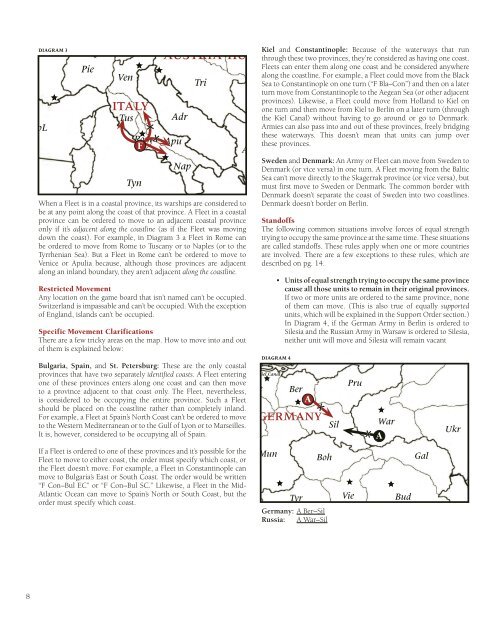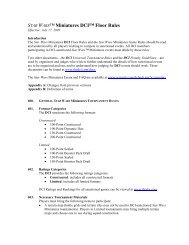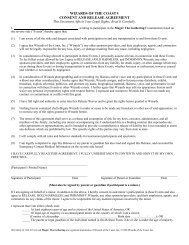Diplomacy Rulebook - Wizards of the Coast
Diplomacy Rulebook - Wizards of the Coast
Diplomacy Rulebook - Wizards of the Coast
You also want an ePaper? Increase the reach of your titles
YUMPU automatically turns print PDFs into web optimized ePapers that Google loves.
DIAGRAM 3<br />
F<br />
When a Fleet is in a coastal province, its warships are considered to<br />
be at any point along <strong>the</strong> coast <strong>of</strong> that province. A Fleet in a coastal<br />
province can be ordered to move to an adjacent coastal province<br />
only if it’s adjacent along <strong>the</strong> coastline (as if <strong>the</strong> Fleet was moving<br />
down <strong>the</strong> coast). For example, in Diagram 3 a Fleet in Rome can<br />
be ordered to move from Rome to Tuscany or to Naples (or to <strong>the</strong><br />
Tyrrhenian Sea). But a Fleet in Rome can’t be ordered to move to<br />
Venice or Apulia because, although those provinces are adjacent<br />
along an inland boundary, <strong>the</strong>y aren’t adjacent along <strong>the</strong> coastline.<br />
Restricted Movement<br />
Any location on <strong>the</strong> game board that isn’t named can’t be occupied.<br />
Switzerland is impassable and can’t be occupied. With <strong>the</strong> exception<br />
<strong>of</strong> England, islands can’t be occupied.<br />
Specific Movement Clarifications<br />
There are a few tricky areas on <strong>the</strong> map. How to move into and out<br />
<strong>of</strong> <strong>the</strong>m is explained below:<br />
Bulgaria, Spain, and St. Petersburg: These are <strong>the</strong> only coastal<br />
provinces that have two separately identified coasts. A Fleet entering<br />
one <strong>of</strong> <strong>the</strong>se provinces enters along one coast and can <strong>the</strong>n move<br />
to a province adjacent to that coast only. The Fleet, never<strong>the</strong>less,<br />
is considered to be occupying <strong>the</strong> entire province. Such a Fleet<br />
should be placed on <strong>the</strong> coastline ra<strong>the</strong>r than completely inland.<br />
For example, a Fleet at Spain’s North <strong>Coast</strong> can’t be ordered to move<br />
to <strong>the</strong> Western Mediterranean or to <strong>the</strong> Gulf <strong>of</strong> Lyon or to Marseilles.<br />
It is, however, considered to be occupying all <strong>of</strong> Spain.<br />
If a Fleet is ordered to one <strong>of</strong> <strong>the</strong>se provinces and it’s possible for <strong>the</strong><br />
Fleet to move to ei<strong>the</strong>r coast, <strong>the</strong> order must specify which coast, or<br />
<strong>the</strong> Fleet doesn’t move. For example, a Fleet in Constantinople can<br />
move to Bulgaria’s East or South <strong>Coast</strong>. The order would be written<br />
“F Con–Bul EC” or “F Con–Bul SC.” Likewise, a Fleet in <strong>the</strong> Mid-<br />
Atlantic Ocean can move to Spain’s North or South <strong>Coast</strong>, but <strong>the</strong><br />
order must specify which coast.<br />
Kiel and Constantinople: Because <strong>of</strong> <strong>the</strong> waterways that run<br />
through <strong>the</strong>se two provinces, <strong>the</strong>y’re considered as having one coast.<br />
Fleets can enter <strong>the</strong>m along one coast and be considered anywhere<br />
along <strong>the</strong> coastline. For example, a Fleet could move from <strong>the</strong> Black<br />
Sea to Constantinople on one turn (“F Bla–Con”) and <strong>the</strong>n on a later<br />
turn move from Constantinople to <strong>the</strong> Aegean Sea (or o<strong>the</strong>r adjacent<br />
provinces). Likewise, a Fleet could move from Holland to Kiel on<br />
one turn and <strong>the</strong>n move from Kiel to Berlin on a later turn (through<br />
<strong>the</strong> Kiel Canal) without having to go around or go to Denmark.<br />
Armies can also pass into and out <strong>of</strong> <strong>the</strong>se provinces, freely bridging<br />
<strong>the</strong>se waterways. This doesn’t mean that units can jump over<br />
<strong>the</strong>se provinces.<br />
Sweden and Denmark: An Army or Fleet can move from Sweden to<br />
Denmark (or vice versa) in one turn. A Fleet moving from <strong>the</strong> Baltic<br />
Sea can’t move directly to <strong>the</strong> Skagerrak province (or vice versa), but<br />
must first move to Sweden or Denmark. The common border with<br />
Denmark doesn’t separate <strong>the</strong> coast <strong>of</strong> Sweden into two coastlines.<br />
Denmark doesn’t border on Berlin.<br />
Stand<strong>of</strong>fs<br />
The following common situations involve forces <strong>of</strong> equal strength<br />
trying to occupy <strong>the</strong> same province at <strong>the</strong> same time. These situations<br />
are called stand<strong>of</strong>fs. These rules apply when one or more countries<br />
are involved. There are a few exceptions to <strong>the</strong>se rules, which are<br />
described on pg. 14.<br />
DIAGRAM 4<br />
• Units <strong>of</strong> equal strength trying to occupy <strong>the</strong> same province<br />
cause all those units to remain in <strong>the</strong>ir original provinces.<br />
If two or more units are ordered to <strong>the</strong> same province, none<br />
<strong>of</strong> <strong>the</strong>m can move. (This is also true <strong>of</strong> equally supported<br />
units, which will be explained in <strong>the</strong> Support Order section.)<br />
In Diagram 4, if <strong>the</strong> German Army in Berlin is ordered to<br />
Silesia and <strong>the</strong> Russian Army in Warsaw is ordered to Silesia,<br />
nei<strong>the</strong>r unit will move and Silesia will remain vacant<br />
A<br />
Germany: A Ber–Sil<br />
Russia: A War–Sil<br />
A<br />
8

















